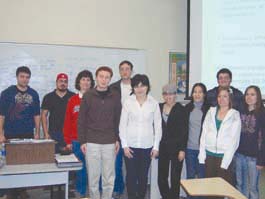Armen Melidonian
Staff Writer

Photo: Barlow Der Mugrdechian
The Armenian Studies Program offered a course, Armenian Studies 120T-Armenia Today, which covered the history and development of the modern Republic of Armenia, on Friday, February 19 and Saturday, February 20. The course also covered Armenia in the early twentieth century and in the period of the Soviet Union. Events leading to Armenia’s independence nearly two decades ago and the state of the nation today, including the issue of neighboring Nagorno-Karabagh Republic were also discussed.
Prof. Barlow Der Mugrdechian taught the course, presenting photos and videos from his frequent visits as well as his insight from first-hand experience witnessing economic, social, and political developments at various times of the Republic’s modern existence.
Prof. Der Mugrdechian has visited Armenia more than twenty times, from his first visit in 1978 when Armenia was part of the Soviet Union, to his latest visit in fall of 2009. He outlined the history of Armenia in the period of 1988-1991, before its independence.
Dr. Kristine Antonyan, who is visiting Fresno State for the Spring 2010 semester as part of the Junior Faculty Development Program, was a guest lecturer for the course. She is a lecturer at the Faculty of Economics at Yerevan State University in Armenia, and has lived in Armenia her entire life. For the “Armenia Today” course, her presentation and discussion provided comprehensive insight into economic development in the modern Republic.
The Armenian people are an ancient people, whose history extends back several millennia, involving periods of self-rule and foreign domination. However the modern Republic of Armenia was established only recently and its history is intertwined with the legacy of this past century’s global superpowers.
The history of the modern Republic of Armenia can be divided into several periods. Eastern Armenia had existed as part of the Russian Empire from 1828 until 1918, when the first Republic was formed. Many Western Armenian survivors of the Genocide had entered Eastern Armenia as refugees. This first independent Republic lasted until November 29, 1920, when the Russian communists took over and eventually the Armenian Soviet Socialist Republic was formed. Karabagh during this period was administratively put under the Azerbaijan Socialist Republic.
From 1920 to 1930, communism had begun to be imposed on Armenia. It was the Armenian peasant class that was most affected by the new and alien ideology. Stalin’s strict regime was in power from 1930 to 1953, making communist ideology’s influence much more pervasive and controlling. In these early periods under Soviet rule, the teaching of religion was banned and most Armenian churches were inactive, with the exception of Etchmiadzin. From 1953 to 1988, Soviet policy was more relaxed, and Armenian life in this period was markedly better overall.
Beginning in 1987, in the Gorbachev era, open criticism was allowed of problems that arose due to communist policy. After the Armenian earthquake of 1988, there were protests over the inadequate construction practices in Leninakan (Gyumri) and Spitak, due to corruption and lack of oversight by Soviet officials. This contributed to the death toll of over 100,000. The Soviet Union initially assisted in the rebuilding effort, but when the Union collapsed, the reconstruction efforts froze.
The Soviet Union’s decline led to conflicts over national borders between Armenia and Azerbaijan, as the Armenians of Karabagh sought freedom from Azerbaijani rule. An independent Azerbaijan emerged with Soviet-era claims over the Armenian-populated Karabagh region, while the Karabagh Committee in Armenia supported Karabagh’s autonomy. The Karabagh War lasted from 1988 to 1994, with the issue of recognition still unresolved.
Armenia officially became an independent Republic once again on September 21, 1991, and since then Armenia has continued to deal with societal issues, a delicate foreign policy situation, and economic problems.
Students were assigned to do introductory research and write analysis papers on current issues facing Armenia. With such complex issues and foreign relations inherited from the Soviet Union, a great deal of modern Armenia’s history was taught, presented, and discussed during this educational course.
 Hye Sharzhoom Armenian Action
Hye Sharzhoom Armenian Action